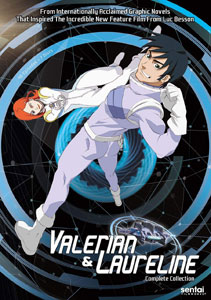In its final 10 episodes, “Valerian and Laureline: Time Jam” wraps up by riffing heavily on the “Star Wars” prequels, but it stands as its own thing thanks to its trademark bevy of wild ideas – many involving time travel, as the series fully embraces its title. And as had been telegraphed in the sitcom-esque bickering flirtation (or flirtatious bickering?) heading into the closing credits of many episodes, the saga’s final statement is about Valerian’s and Laureline’s relationship … although it’s not exactly what I hoped for.
Mostly a series of standalone episodes before this, “Time Jam” gets heavily serialized in its final six episodes, which are two trilogies. First up is the “Star Wars” prequel parallel: Episodes 35 (“A Matter of Time”), 36 (“A Waste of Time”) and 37 (“In Times of War”) form a Vlagos-versus-Aldebaran trilogy that riffs on Trade-Federation-versus-the-Naboo. V&L and their Freedom Rebel allies capture video evidence of the Vlagos building an army. Queen Amidala and friends perhaps should’ve snapped a few pix of the Trade Federation invasion before departing Naboo to go before the Senate so as not to be met with Nute Gunray’s complaint of “Where is the evidence?” But most likely Darth Sidious had a backup plan for that situation anyway.
In “Time Jam,” Gork Yodol and the Vlagos have set it up so it looks like its army is needed against the Aldebaran (who we know to be peaceful), making our heroes’ evidence suddenly worthless. It’s similar to what Darth Sidious does by creating the Separatists, except it’s a complete ruse here. It’s an interesting commentary on how modern technology provides opportunities to create an artificial narrative out of whole cloth.
I would be stunned if the “Time Jam” writers and animators weren’t drawing from “Star Wars” (the Parliament chamber even has floating pods like the Republic Senate). But if any franchise has earned the right to crib from “Star Wars,” it’s this one, since the original “Star Wars” trilogy heavily borrowed from Christin and Mezieres’ “Valerian” comics in the 1970s (although historians have been slow to recognize the connection).
After the “Star Wars” riff, the final three episodes (38, “Long Time No See”; 39, “The Test of Time”; and 40, “Only Time Will Tell”) are more purely “Valerian” as the writers bring “Time Jam” full circle back to the series-launching mystery of why and how the Earth disappeared. They save their best work for this closing trilogy as V&L learn the full scope of the galactic threat: Raymond de Tancarville, a descendant of the man who aimed to execute Laureline in 912 in the pilot episode, has an ingenious scheme. In a legitimate “wow” moment, we learn he didn’t merely team up with the Vlagos, he created the entire species thousands of years in the past to serve his ends, by traveling through time.
“Time Jam” ties together nicely when Valerian and de Tancarville chase each other through moments of galactic history, and moments we’ve seen in this series. The two closing trilogies feature some of the best voice work (de Tancarville is a fun cartoon villain) and most colorful action scenes (the battle above Aldebaran is wondrous). More impressive still, there’s momentum to the proceedings, as “Time Jam” overcomes its notorious pacing problem.

In this final batch of 10 episodes, “Time Jam” digs into Mr. Albert and the Shingouz trio, both popular from the comics. The cartoon’s writers have made Mr. Albert a major player in the time-travel game, whereas in the comics, he is just one agent in the Spatio-Temporal Agency – one who doesn’t even have clearance for time travel. It doesn’t make much sense that “Time Jam’s” Mr. Albert preaches about not interfering with timelines while constantly doing just that. If it’s supposed to be winking humor, it gets lost in translation from French to English, but I suspect it’s one of the several bits of clunkiness on the show.
Another thing that makes no sense is how V&L and Mr. Albert become invisible by “going back 2 seconds in time.” While it’s true that the “Valerian” franchise has always dealt with wild sci-fi ideas, those ideas come from a foundation of science in Christin and Mezieres’ comics; this “2 seconds” thing is mumbo-jumbo. By contrast: One of the Freedom Rebels, Klinch, frees the entire population of Aldebaran with a device that makes everyone invisible to the invaders, but it works because we get a full explanation of how the device delivers subliminal messages.
“Time Jam” is capable of greatness, though, and “Time Is Money” (32) is the strongest standalone from this batch. It explores Shingouz culture, and does so by hewing closely to the comics – more closely than the series does with any other element, including the title characters. The planet is rainy and miserable, but has a sad beauty to it. In nice parodies of monetization, visitors must pay for the right to breathe the air on Planet Shingouz, and every Shingouz has their net worth displayed on a holographic screen that floats above their head.
The other three episodes in this batch are more forgettable; indeed, “Springtime in Paris” (33) finds Valerian with amnesia. The ep doesn’t play up Laureline’s need to get him back to his old self as much as it should, although there is nice Paris animation to go with the soft V&L music theme. (Like many animated shows, “Time Jam” has three themes – soft, dramatic and action. And like many animated shows, it would be better with a deeper music library.)
Similarly, “In Next to No Time” (34) doesn’t quite deliver. It’s built for comedy – V&L disguise themselves as members of the Vlagos species – but is short on chuckles. The design of the Vlagos planet, with its rings of garbage, is suitably alien, though. Although it offers potential for characterization, “Time for a Change” (32) is an uneven episode where Valerian is obsessed with a treasure map and Laureline is continually assailed by bad luck.
Over the course of “Time Jam’s” 40 episodes, the V&L relationship plays like the writers all received a broad direction to have them flirt and bicker (with a heavy emphasis on the latter).
I admit I was hoping for a grand romantic finale to make it worth wading through those clichéd moments, but as I reflect on it I’ll probably accept the softer touch the writers choose. Valerian goes off to explore space, while Laureline stays on her beloved (and recently rediscovered) home planet of Earth. After nine months, Valerian returns because he misses Laureline, and she’s thrilled that he’s back. Then they both shoot off into space in the Tempus Fugit: The adventure resumes. No marriage; no closing kiss (although they had kissed twice before – and brushed it off later); no flash-forward to a glowing, pregnant Laureline; no hand-in-hand walk into the sunset.
I guess the romantic hints are the love story – including Laureline crying the two times Valerian appears to be dead, and Valerian wanting to tell Laureline something in a moment when it appears they are doomed. (I strongly suspect he didn’t aim to say “You’re a pretty good pilot, for a girl.”) Or perhaps the closing image of episode 38 sums it up: From a bridge, the duo views Paris (the city of romance) at dusk.
I might be stretching for the sake of wanting to love this love story. The facial-expression animation could be stronger, but the chemistry between the English voice actors gets better as “Time Jam” moves along, and there’s no doubt Valerian and Laureline have vibrant personalities. Where they fall a bit short is character growth.
As I noted back in my first “Time Jam” review, this ain’t your comic-book Valerian and Laureline, and mostly that’s for the worse. I prefer them being openly in love, as I suspect most fans do, and I’ll be happy to get back to exploring Christin and Mezieres’ comics. Still, “Time Jam” is its own thing, and there’s some appeal to the way it plays things. Maybe both versions are true … in alternate timelines.
More “Time Jam” reviews:
Click here for a complete index of “Valerian and Laureline” reviews.

